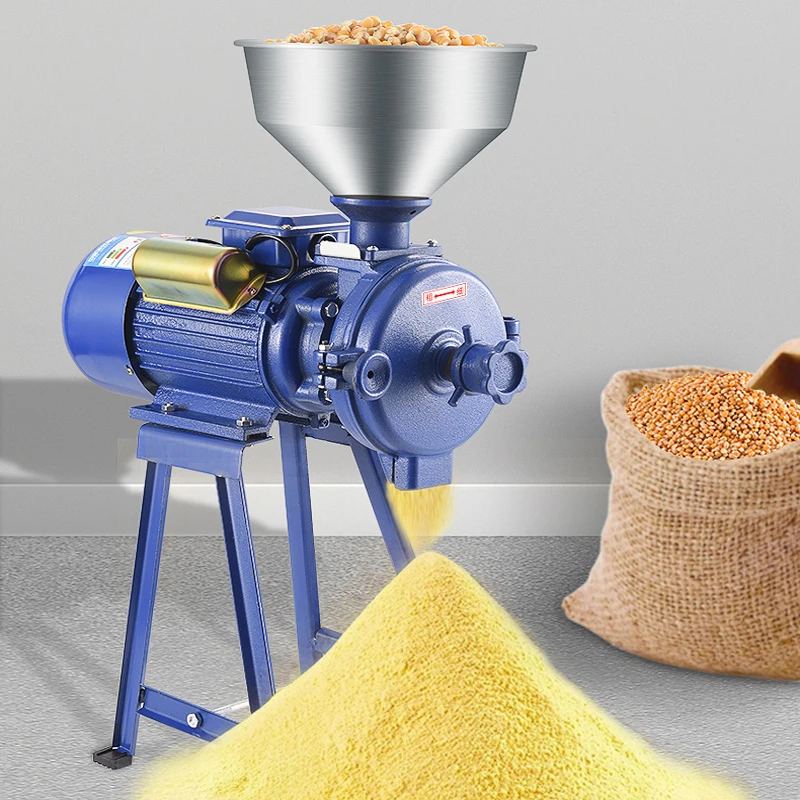Starting a milling company can be an exciting and lucrative venture for those interested in the field of milling and grain processing. However, like any other business, it requires careful planning, research, and execution. In this article, we will provide a step-by-step guide on how to start a milling company, covering key aspects such as market research, business planning, financing, legal requirements, equipment and facilities, staffing, marketing, and operations.
Market Research
Market research is a crucial step in starting any business, including a milling company. Conducting thorough market research helps in understanding the demand for milled products in the target market, assessing the competition, and identifying market trends. Here are some key points to consider in the market research process:

Identifying the demand for milled products:
Conduct a market analysis to identify the demand for various types of milled products in your target market. This may include products such as flour, feed, or specialty milled products. Determine the size of the market, the potential customer base, and their preferences.
Assessing the competition
Identify and analyze the competitors in the milling industry in your target market. This may include other milling companies, large-scale industrial mills, or local artisan mills. Understand their strengths, weaknesses, pricing, distribution channels, and customer base. This information will help you develop strategies to differentiate your milling company from the competition.
Analyzing market trends:
Stay updated with the latest trends in the milling industry, including changes in consumer preferences, technological advancements, and regulatory requirements. Analyze how these trends may impact the demand for milled products and the overall milling industry in your target market.
Collecting data
Use various sources such as market reports, industry publications, government statistics, and customer surveys to collect data on market size, growth rate, customer preferences, pricing, and distribution channels. This data will provide valuable insights for making informed decisions in the business planning process.
Business Planning
A well-structured business plan is critical for the success of any milling company. It serves as a roadmap for your business, outlining your goals, strategies, financial projections, and implementation plan. Here are key points to consider in the business planning process:
Defining the company’s vision, mission, and core values
Clearly define the vision and mission of your milling company, and identify the core values that will guide your business decisions and operations. This will help you establish a strong brand identity and set the direction for your company’s growth.
Conducting a SWOT analysis
Conduct a thorough SWOT (Strengths, Weaknesses, Opportunities, and Threats) analysis of your milling company. Identify the strengths and weaknesses of your business, as well as the opportunities and threats in the market. This analysis will help you understand your company’s internal and external factors and develop strategies to leverage your strengths and opportunities, and address your weaknesses and threats.
Setting realistic goals and objectives
Set realistic short-term and long-term goals and objectives for your milling company. These goals should be specific, measurable, achievable, relevant, and time-bound (SMART). They should align with your company’s vision and mission and serve as benchmarks for monitoring your progress and success.
Creating a marketing strategy
Develop a comprehensive marketing strategy for your milling company, including your target market, pricing strategy, distribution channels, promotional activities, and branding. Your marketing strategy should be aligned with your market research findings and business goals, and should be regularly reviewed and updated to adapt to changing market dynamics.
Financial projections
Prepare detailed financial projections for your milling company, including sales forecasts, operating expenses, capital requirements, and cash flow projections. This will help you assess the financial viability of your milling company and plan for adequate funding to start and sustain your business. Include realistic assumptions and consider different scenarios to understand the potential risks and challenges in the financial aspect of your business.
Legal requirements
Understand the legal requirements for starting a milling company in your region or country. This may include obtaining necessary permits, licenses, and certifications, complying with food safety regulations, and adhering to labor laws. Consult with legal experts or business advisors to ensure that you are in compliance with all the relevant laws and regulations.
Financing
Financing is a critical aspect of starting any business, including a milling company. Securing adequate funding is essential to cover the initial costs of setting up the business, purchasing equipment and facilities, and covering operational expenses. Here are some key points to consider in the financing process:
Assessing the funding needs
Calculate the estimated costs of starting and operating your milling company, including equipment, facilities, labor, raw materials, utilities, marketing, and other overhead expenses. Determine the total funding needs and develop a plan to secure adequate funding from various sources such as personal savings, loans, investors, or grants.
Researching funding options
Research and identify the available funding options for your milling company. This may include traditional bank loans, Small Business Administration (SBA) loans, venture capital, angel investors, crowdfunding, or government grants. Understand the requirements, terms, and conditions of each funding option, and assess their feasibility for your business.
Developing a funding strategy
Develop a funding strategy based on your funding needs, business plan, and financial projections. This may include a combination of funding sources to diversify your risk and ensure adequate funding for your business. Prepare a compelling pitch or business plan to present to potential investors or lenders to secure the necessary funding.
Managing cash flow
Cash flow management is crucial for the success of your milling company. Develop a cash flow plan to monitor and manage your inflows and outflows of cash. Ensure that you have sufficient cash reserves to cover operational expenses, loan payments, and unforeseen expenses. Consider implementing effective cash flow management practices such as budgeting, inventory management, and payment terms with suppliers to maintain healthy cash flow in your business.
Equipment and Facilities
The right equipment and facilities are essential for the efficient operation of a milling company. Depending on the type and scale of your milling operation, you may require different types of milling equipment, storage facilities, and processing facilities. Here are key points to consider in the equipment and facilities aspect of your milling company:
Identifying equipment needs:
Identify the specific milling equipment required for your business, such as flour mills, grain cleaners, grain dryers, storage bins, conveyors, and packaging equipment. Consider factors such as production capacity, product quality, efficiency, and cost-effectiveness in selecting the right equipment for your milling operation. Conduct thorough research, compare different options, and seek advice from industry experts or equipment suppliers to make informed decisions.
Assessing facility requirements
Assess the facility requirements for your milling company, including the size, location, layout, and infrastructure needed for your milling operation. Consider factors such as accessibility, safety, sanitation, and regulatory compliance in selecting the right facility for your business. Ensure that your facility has adequate space for milling equipment, storage of raw materials and finished products, and other operational activities.
Obtaining equipment and facilities
Once you have identified your equipment and facility requirements, develop a plan to acquire or lease the necessary equipment and facilities. Consider factors such as cost, financing options, warranties, maintenance, and support services in making your decisions. Work with reputable suppliers or vendors to ensure that you are obtaining reliable and high-quality equipment and facilities that meet industry standards.
Maintenance and repair
Regular maintenance and repair of milling equipment and facilities are essential to ensure their smooth operation and longevity. Develop a maintenance plan and schedule for your equipment and facilities, and allocate resources for routine inspections, repairs, and replacements. Train your staff on proper equipment handling and maintenance procedures to minimize downtime and maximize productivity.
Marketing and Sales
Effective marketing and sales strategies are crucial to promote your milling company and attract customers. Here are some key points to consider in the marketing and sales aspect of your milling company:
Market research
Conduct market research to understand the demand for milled products in your target market. Identify your target customers, their preferences, needs, and purchasing behaviors. Research your competitors, their pricing, product offerings, and marketing strategies to identify opportunities for differentiation and competitive advantage.
Branding and positioning
Develop a strong brand identity and positioning for your milling company. This includes creating a compelling brand name, logo, website, and marketing materials that reflect the unique value proposition of your business. Position your milling company as a reliable and trustworthy provider of high-quality milled products.
Marketing channels
Identify and utilize effective marketing channels to reach your target customers. This may include online marketing through social media, search engine optimization (SEO), pay-per-click (PPC) advertising, and content marketing. It may also include traditional marketing methods such as print advertisements, trade shows, and networking events. Develop a marketing plan and budget to allocate resources effectively across different marketing channels.
Sales strategies
Develop sales strategies to attract and retain customers. This may include offering competitive pricing, promotions, discounts, and loyalty programs. Build relationships with potential customers and establish a strong customer service culture in your milling company. Provide excellent customer service, respond to customer inquiries promptly, and address any issues or complaints in a timely and professional manner.
Operations and Management
Efficient operations and effective management are essential for the smooth and profitable operation of your milling company. Here are some key points to consider in the operations and management aspect of your business:
Standard operating procedures (SOPs)
Develop standard operating procedures for all aspects of your milling operation, including milling processes, equipment operation, safety procedures, quality control, and inventory management. Train your staff on these SOPs to ensure consistency, efficiency, and safety in your operations.
Staffing and training
Hire and train a competent and skilled workforce for your milling company. Develop job descriptions, recruit qualified personnel, and provide ongoing training and development opportunities to improve their skills and knowledge. Create a positive and inclusive work culture that fosters teamwork, accountability, and innovation.
Quality control
Implement robust quality control measures to ensure that your milled products meet the highest standards of quality and safety. Conduct regular quality checks, inspections, and testing of your products to maintain consistency and customer satisfaction. Implement proper food safety practices, including proper storage, handling, and labeling of raw materials and finished products.
Inventory management
Efficient inventory management is crucial in a milling company to optimize production, minimize waste, and ensure product availability. Implement effective inventory control practices, including proper storage, tracking, and rotation of raw materials and finished products. Utilize inventory management software or systems to streamline your inventory operations and minimize stockouts or overstocks.
Financial management
Implement effective financial management practices in your milling company to monitor and control your business finances. Develop a system for bookkeeping, budgeting, financial reporting, and tax compliance. Regularly review your financial statements, cash flow projections, and performance metrics to make informed decisions and ensure the financial health of your business.
Risk management
Identify and mitigate risks that may affect the operations and profitability of your milling company. This may include risks related to equipment breakdowns, supply chain disruptions, regulatory compliance, and market fluctuations. Develop contingency plans, insurance coverage, and risk mitigation strategies to minimize the impact of potential risks on your business.
Strategic planning
Develop a strategic plan for your milling company to guide its growth and expansion. Set short-term and long-term goals, identify opportunities for diversification or expansion, and develop strategies to capitalize on them. Regularly review and update your strategic plan to adapt to changing market conditions and business environment.
Leadership and communication
Effective leadership and communication are crucial for the success of your milling company. Provide clear direction, set expectations, and establish open lines of communication with your staff. Foster a positive and collaborative work environment that encourages creativity, innovation, and continuous improvement. Lead by example and motivate your team to achieve the company’s goals and objectives.
Conclusion
Starting and operating a successful milling company requires careful planning, diligent execution, and effective management. By considering the key aspects outlined in this article, you can lay a solid foundation for your milling business and increase your chances of success in this competitive industry.
Remember to conduct thorough market research, develop a comprehensive business plan, secure necessary permits and licenses, invest in reliable equipment and facilities, implement effective marketing and sales strategies, ensure efficient operations and management practices, and continuously monitor and adapt to changing market conditions.
With careful planning, attention to detail, and a commitment to quality and customer satisfaction, your milling company can thrive and become a trusted provider of high-quality milled products in the market. Good luck on your milling business venture!












